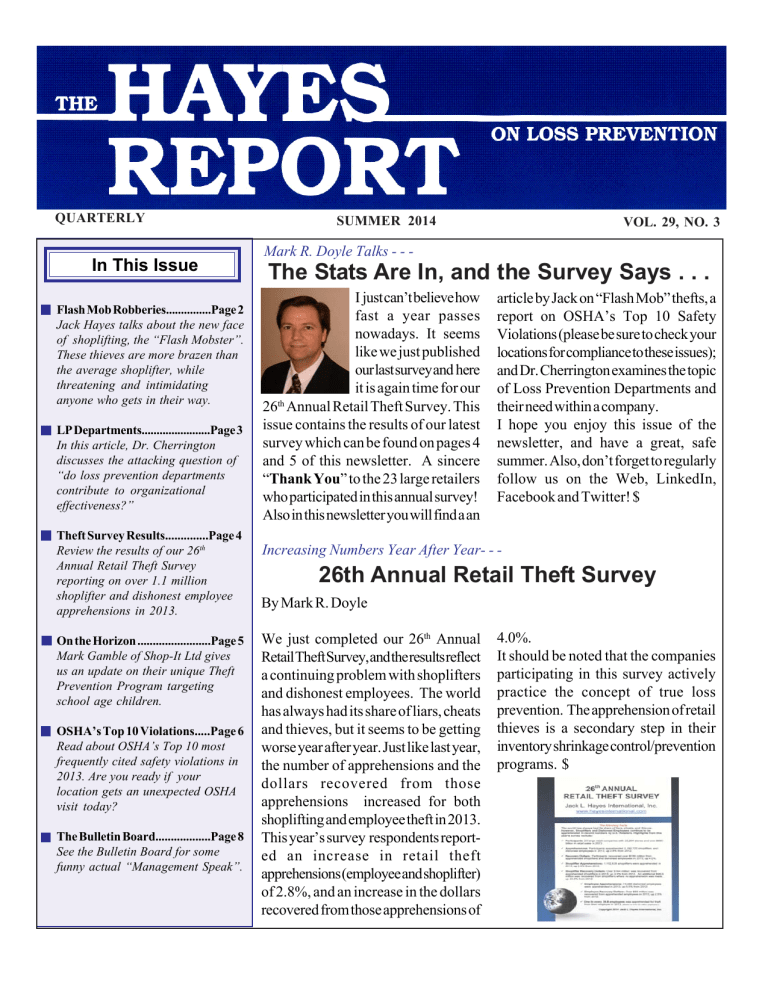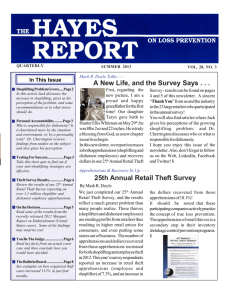nl-hayes-report-summer-2014-vol-29-no3

QUARTERLY
In This Issue
Flash Mob Robberies...............Page 2
Jack Hayes talks about the new face of shoplifting, the “Flash Mobster”.
These thieves are more brazen than the average shoplifter, while threatening and intimidating anyone who gets in their way.
LP Departments.......................Page 3
In this article, Dr. Cherrington discusses the attacking question of
“do loss prevention departments contribute to organizational effectiveness?”
SUMMER 2014 VOL. 29, NO. 3
Mark R. Doyle Talks - - -
The Stats Are In, and the Survey Says . . .
I just can’t believe how fast a year passes nowadays. It seems like we just published our last survey and here it is again time for our
26 th Annual Retail Theft Survey. This issue contains the results of our latest survey which can be found on pages 4 and 5 of this newsletter. A sincere
“ Thank You ” to the 23 large retailers who participated in this annual survey!
Also in this newsletter you will find a an article by Jack on “Flash Mob” thefts, a report on OSHA’s Top 10 Safety
Violations (please be sure to check your locations for compliance to these issues); and Dr. Cherrington examines the topic of Loss Prevention Departments and their need within a company.
I hope you enjoy this issue of the newsletter, and have a great, safe summer. Also, don’t forget to regularly follow us on the Web, LinkedIn,
Facebook and Twitter! $
Theft Survey Results..............Page 4
Review the results of our 26 th
Annual Retail Theft Survey reporting on over 1.1 million shoplifter and dishonest employee apprehensions in 2013.
Increasing Numbers Year After Year- - -
26th Annual Retail Theft Survey
By Mark R. Doyle
On the Horizon ........................Page 5
Mark Gamble of Shop-It Ltd gives us an update on their unique Theft
Prevention Program targeting school age children.
OSHA’s Top 10 Violations.....Page 6
Read about OSHA’s Top 10 most frequently cited safety violations in
2013. Are you ready if your location gets an unexpected OSHA visit today?
The Bulletin Board..................Page 8
See the Bulletin Board for some funny actual “Management Speak”.
We just completed our 26 th Annual
Retail Theft Survey, and the results reflect a continuing problem with shoplifters and dishonest employees. The world has always had its share of liars, cheats and thieves, but it seems to be getting worse year after year. Just like last year, the number of apprehensions and the dollars recovered from those apprehensions increased for both shoplifting and employee theft in 2013.
This year’s survey respondents reported an increase in retail theft apprehensions (employee and shoplifter) of 2.8%, and an increase in the dollars recovered from those apprehensions of
4.0%.
It should be noted that the companies participating in this survey actively practice the concept of true loss prevention. The apprehension of retail thieves is a secondary step in their inventory shrinkage control/prevention programs. $
HAYES REPORT * LOSS PREVENTION * HAYES REPORT * LOSS PREVENTION
Intimidating and Dangerous - - -
Did You Know
Flash Mob Robberies
By Jack L. Hayes Workers who believe their organization encourages healthy behaviors tend to be less stressed and more in control of their wellbeing.
Aon Hewitt Survey
The average cargo loss is $171,146, with Electronics at the highest average loss ($413,550), followed by Alcohol/Tobacco ($269,000), and then Clothing/Shoes ($286,427).
FreightWatch International
Recent statistics on the impact of organized retail crime revealed:
• ORC is a $30 billion a year problem.
have been a victim of ORC.
reported their online operations were affected by ORC.
• ORC has one of the highest levels of concern among retailers.
• Over 74% of retailers are now allocating special resources to fight and combat ORC.
or recovered stolen merchandise from a physical fence (pawn shop, flea market), and 68.2% have recovered merchandise from an efencing location (auction site, 3 rd party website).
NRF’s 10 th Annual ORC Survey
Nearly 90% of respondents indicated their top reason for committing burglaries was related to the need to acquire drugs (51%) or money (37%). And slightly less than a third of the offenders reported they collected information about a potential target prior to initiating a burglary attempt.
Alarm Industry Research and
Educational Foundation (AIREF)
Well, it’s that time of year again.
Hayes International has released its
26 th Annual Retail Theft Survey, and the crime of shoplifting continues to set new records. We are also finding that as incidents of shoplifting increase, acts of intimidation and violence are also becoming more prevalent.
Sure we still have hundreds of thousands of thieves that best fit into such categories as amateur, hardcore, organized crime professional, and drug addict. Now, the shoplifter has taken on a new face; “Flash Mobster”.
These thieves are more brazen than the average shoplifter, while threatening, intimidating and harming anyone who gets in their way as they sweep entire shelves of goods into bags, push loaded rolling racks of merchandise out the door at a high rate of speed—there is little, if anything, a store employee can do to prevent these actions once underway.
Examples:
- A group of at least four to six people tried to steal armfuls of clothes from a store and started shooting a gun when employees tried to stop them. A male friend of the store’s owner was killed and a female customer was shot in the leg.
- One specialty store reported that
11 teens stormed through its doors knocking over fixtures, stealing items, and threatening customers.
- In a YouTube tape, 50 teens can be seen entering a convenience store.
Within less than 4 minutes they had taken whatever they wanted and left the store.
- A gang of brazen female shoplifters invaded a large retail store and stole thousands of dollars in merchandise.
- A group of men ripped off thousands of dollars in merchandise in a string of flash mob robberies at one city and two suburban sporting goods stores.
When an employee attempted to stop the robbers at one store, he was trampled.
- Five men rushed into a department store, snatched dozens of high-end handbags and fled to their getaway car that was parked outside the door.
The M.O. of the Flash Mobster varies:
At times these thieves will casually filter somewhat unnoticed into the store, pretend to browse, and then go into action by grabbing armfuls of merchandise, or taking rolling racks of clothing and running out the door. There are also those large groups who most brazenly walk into the store in a forceful and intimating manner, and take as many items as they can carry or place on rolling racks.
Investigators indicate that these types of crimes are often planned ahead by using social media alerts, and that all of those involved do not personally know each other.
Technically, I find that these types of crimes better fit the legal definition of robbery than as a form of shoplifting or larceny. And, that is a good thing!
Those convicted of robbery will likely spend much greater time behind bars than will the shoplifter.
Retailers are encouraged to brief their staffs regarding specific policies and procedures as to what actions those
Continued on Page 7
Page 2 THE HAYES REPORT
HAYES REPORT * LOSS PREVENTION * HAYES REPORT * LOSS PREVENTION
Assessing Effectiveness - - -
Loss Prevention Departments
By Dr. David J. Cherrington
Do loss prevention departments contribute to organizational effectiveness or should they be eliminated?
Could the functions of an LP department be performed more efficiently by line managers or other departments, and would things run smoother if LP’s bureaucratic policies were eliminated?
These same questions are often asked about the human resource departments.
Every two or three years someone writes an article suggesting that companies could save a lot of money and be more effective if they totally eliminated their HR department. The latest attack appeared in the Wall Street
Journal (“Companies Say No to
Having an HR Department: Employers
Come Up With New Ways to Manage
Hiring, Firing and Benefits,” April 8,
2014). The central theme of these articles is much the same: HR people don’t contribute to the bottom line, they don’t know what it takes to make a profit, they perpetuate worthless forms that waste time to complete, and the things they do could be done more effectively by line managers.
These attacks on HR are very threatening to some HR people and some companies actually take their advice and eliminate their HR departments. Nevertheless, these articles often serve a useful purpose in spite of their inflammatory rhetoric because they force executives and HR managers to strategically assess the HR functions and how they can best be performed. Bureaucratic procedures and unnecessary policies are often
SUMMER 2014 revised or eliminated.
A similar strategic assessment should occasionally be made regarding the functions of a loss prevention department. What does the LP department do and should some of these responsibilities be distributed more widely within an organization? Is loss prevention the sole responsibility of the LP department or does everyone share some of this responsibility?
Involving others is essential to building a culture of integrity. Such a culture requires the involvement of more than just the LP department; all managers and supervisors need to participate in endorsing the rules, enforcing them, and modeling good behavior.
Training is an especially important function that could profitably be delegated to involve other people in the organization. Loss prevention training is extremely important and all employees need to understand the company’s policies and internal control procedures; but, should the LP department be the only group to present this training? Principles of persuasive communication suggests that this training would be more effective if it were presented by line managers or entry-level employees who have been asked and coached to present it.
Occasionally it is healthy to step back and challenge the existence of a department. What does it do and who should do it? What are its policies and procedures and should they be revised? $
Testing
For Success
As the results of our 26 th
Annual Retail Theft Survey reflect, shoplifters and dishonest employees continue to plague the retail industry. Take our short quiz to find out if your anti-theft strategies are effective.
SHOPLIFTING
1. Are your anti-shoplifting safeguards equal to or greater than your competitors? Yes No
2. Are all store associates taught that effective customer service is the best deterrent to shoplifting; and have they been adequately trained in preventing shoplifting?
Yes No
3. Are high value/highly pilferable items displayed on the sales floor adequately protected; and do you have good sight lines to easily view these items (no blind spots)?
Yes No
INTERNAL THEFT
4. Do you have a thorough preemployment screening process in place (and consistently complied with) to help ensure only honest employees are being hired?
Yes No
5. Do you use a confidential reporting line and reward program so employees can easily report their internal theft suspicions?
Yes No
6. Are adequate back door, trash removal, employee package check, and POS controls in place and always being followed? Yes No
Hopefully you were able to answer
“YES” to all six questions above.
If not, take corrective actions now to reduce your vulnerability to theft. $
Page 3
HAYES REPORT * LOSS PREVENTION * HAYES REPORT * LOSS PREVENTION
Believe It or Not
SURVEY PARTICIPANTS
C
23 Large Retail Companies
C
23,204 Stores (representing an excellent cross-section of the U.S.)
C
$669,385,561,011 in Annual Retail Sales (2013)
Thief blunders and great police work!
Oregon police reported in a criminal affidavit, the following: An alleged robber walked into a federal bank, demanded money by giving the teller a note written on the back of one-half of a grocery receipt. While leaving the bank, a bank customer attempted to stop the robber and a struggle ensued. The robber escaped, but not before leaving his stocking cap behind.
Police examination of the grocery receipt revealed the last four digits of a food stamp account number; State records provided a name to go with the account number. Next, a police online search came up with a pawnshop transaction with a telephone number. The phone service provider then came up with the coordinates of where the phone currently was located. The suspect was arrested shortly thereafter. The police informed the suspect that his DNA was on the cap.
Using the telephone of the place you are robbing - not too smart!
A man walked into a convenience store and asked to use the phone to call for help, since his car had run out of gas. After the call, the man robbed the store and took off running. Police used the phone’s redial button and the store’s video surveillance to identify the man. Shortly thereafter, they found him nearby, waiting for the tow truck he had just phoned.
Page 4
TOTAL RETAIL THEFT APPREHENSIONS
Difference
2012 2013 #/$ Pct.
Apprehensions 1,148,648 1,180,720 32,072 2.79%
Recoveries $191,846,599 $199,463,816 $7,617,217 3.97%
Avg. Case Value $167.02 $168.93 $1.91 1.15%
Retail Theft Apprehensions Breakdown
SHOPLIFTING
Difference
2012 2013 #/$ Pct.
Apprehensions 1,075,351 1,102,635 27,284 2.54%
Recoveries $138,056,274 $144,319,615 $6,263,341 4.54%
Avg. Case Value $128.38 $130.89 $2.50 1.95%
Hours Per Appreh.* 38.32 37.30 -2.67%
(*6 companies reporting)
Recoveries $80,715,127 $98,648,755 $17,933,628 22.22%
(No Apprehension Made)
DISHONEST EMPLOYEES
Difference
2012 2013 #/$ Pct.
Apprehensions 73,297 78,085 4,788 6.53%
Recoveries $53,790,325 $55,144,201 $1,353,876 2.52%
Avg. Case Value $733.87 $706.21 -$27.66 -3.77%
THE HAYES REPORT
HAYES REPORT * LOSS PREVENTION * HAYES REPORT * LOSS PREVENTION
HIGHLIGHTS FROM JACK L. HAYES INTERNATIONAL’S
26TH ANNUAL RETAIL THEFT SURVEY
TOTAL RETAIL THEFT
Survey participants apprehended a total of 1,180,720 dishonest individuals
(shoplifters and employees) in 2013, an increase of 2.8% from the prior year. In addition, dollars recovered from those apprehensions totaled over
$199 million, which was a 4.0% increase from 2012.
For every $1.00 recovered by our surveyed companies, $23.26 was lost to retail theft. Therefore, only 4.3% of total retail theft losses resulted in a recovery.
On The Horizon
UK Theft Prevention Program
Update: “Communication’, ‘Unity’ and ‘Continued Collaboration.’ Could it be possible? Maybe so!” The sheer strength in ‘Unity’ from the Security community since I made this statement in the previous article has gone beyond all expectations. “Maybe so!” More like “definitely so!” The continued collaboration from the security industry as a whole is now the backbone of our mission, creating a spine that will not break, and will stay strong and support the campaign until it does succeed.
SHOPLIFTING
Apprehensions: Survey participants apprehended 1,102,635 shoplifters in
2013, an increase of 2.5% from the prior year.
Recoveries: Dollars recovered from shoplifting apprehensions totaled over
$144 million in 2013, a 4.5% increase from 2012.
Case Value: The average shoplifting case value in 2013 was $130.89, which was an increase of 2.0% from 2012’s average case.
For the 17 th consecutive year , dollars recovered from shoplifters where no apprehension was made (over $98 million) increased. In 2013, this increase was an astonishing 22.2%.
Apprehensions: Survey participants apprehended 78,085 dishonest employees in 2013, an increase of 6.5% from the prior year.
Recoveries: Dollars recovered from dishonest employee apprehensions totaled over $55 million in 2013, a 2.5% increase from 2012.
Case Value: The average dishonest employee case value in 2013 was
$706.21, a 3.8% decrease from 2012’s average case value.
One out of every 39.5 employees was apprehended for theft from their employer in 2013. (Based on comparison data of over 3.0 million employees.)
SUMMER 2014
EMPLOYEE THEFT
Organizations such as the Security
Institute, ASIS UK, the International
Professional Security Association
(IPSA), the National Anti Organized
Retail Crime Association (NAORCA) from the US, along with others to follow, and not forgetting the many security related companies from all over the globe, are now helping to make this unique, interactive theft prevention campaign a true success.
Our aim of uniting the Security &
Retail communities is progressing well.
The initial campaign website aimed at attracting the retail industry is scheduled to launch on Tuesday, July
15, 2014, so if you are a retail decision maker or just interested in supporting the campaign make sure you bookmark www.shop-it.co
It is nearly time for the retail sector to take us to the next level and beyond. It is very simple, without the help and support of the retail community this Theft Prevention
Campaign will not succeed in helping to prevent youngsters from starting a life of retail crime!
If your business is in the Security or
Retail Industry please help support this truly, once in a lifetime experience.
Page 5
HAYES REPORT * LOSS PREVENTION * HAYES REPORT * LOSS PREVENTION
2013's Most Cited - - -
OSHA's Top 10 Safety Violations
By Mark R. Doyle
You Be The Judge
Here are key facts from an actual court case. How would you have decided?
An employee in a hurry, decided to use his forklift to reach some boxes, instead of the company supplied ladders. The employee elevated the lift about 10 feet above the floor and stood on an unsecured pallet on the forks. While stretching for a box, he slipped and fell from the front of the unit. Upon landing on the concrete below, the employee broke his leg.
During the OSHA investigation, the company claimed they had showed all their employees where the ladders were located and instructed them on their proper usage. In addition, they informed
OSHA that they had told their employees if they had to use a forklift, they were to secure the pallet and put up the guide rails. When OSHA questioned management regarding the last time they had provided ladder and fork lift training, management responded “We don’t remember the last time we told them about forklift and ladder safety. But these guys know not to use a forklift that way.”
Upon completion of their review,
OSHA cited the company for exposing workers to hazardous conditions. The company appealed, stating the workers had been properly trained and ignored safety precautions.
What’s your verdict?
You will find the court’s decision on the back page.
Page 6
OSHA recently released their 2013 statistics for the “Top 10” most frequently cited violations. We have documented these below and listed the top hazards for each violation which effect our readership.
#1 Fall Protection - General
Requirements: Standard
1926.501
8,241 Violations
Top Sections Cited:
- Failure to provide adequate fall protection
- Failure to supervise employees to prevent falls
#2 Hazard Communication:
Standard 1910.1200
6,156 Violations
Top Sections Cited:
- Failure to develop and maintain a written Haz Comm Program
- Failure to conduct and maintain proper Haz Comm training
- Failure to label hazardous chemical containers
- Obtaining, developing and maintaining MSDS sheets
#3 Scaffolding: Standard
1926.451
5,423 Violations
Top Sections Cited:
- Fall protection on scaffolds
- Guardrail provisions
#4 Respiratory Protection:
Standard 1910.134
3,879 Violations
Top Sections Cited:
- Where respirators are necessary, failure to develop and maintain a written protection program
- Failure to have medical evaluation before use
- Annual fit testing requirements not met
#5 Electrical - Wiring Methods:
Standard 1910.305
3,452 Violations
Top Sections Cited:
- Use of flexible cords and cables
- Failure to provide electrical boxes with proper covers
- Use of temporary wiring / extension cords
#6 Powered Industrial Trucks:
Standard 9101.178
3,340 Violations
Top Sections Cited:
- Failure to ensure operator competency (unsafe operation)
- Failure to ensure required refresher training and evaluations
- Failure to remove unsafe trucks from operation
- Failure to examine trucks before they are used
- Lack of maintenance of industrial trucks
#7 Ladders: Standard 1926.1053
3,311 Violations
Top Sections Cited:
- Failure to extend ladder side rails at least 3 feet above landing surface ladder is used to access
- Using ladders for purposes other than for which they were designed
- Using top step of ladder as a step
- Failure to mark defective ladders with a “Do Not Use” notification
#8 Lockout/Tagout: Standard
1910.347
3,254 Violations
Top Sections Cited:
- Failure to develop and maintain a written Lockout/Tagout Program
Continued on Page 7
THE HAYES REPORT
HAYES REPORT * LOSS PREVENTION * HAYES REPORT * LOSS PREVENTION
Continued from Page 6
ADVISORY BOARD
OSHA's Top 10 Safety Violations
- Failure to periodically inspect the control procedures
- Lack of employee training and communication
- Lockout or tagout devise application
#9 Electrical - General
Requirements: Standard
1910.303
2,745 Violations
Top Sections Cited:
- Failure to install and use electrical equipment as designed
- Failure to keep work spaces clear
- Failure to guard electrical equipment / live parts
#10 Machine Guarding:
Standard 1910.212
2,701 Violations
Top Sections Cited:
- Failure to provide proper machine guarding
- Failure to anchor fixed machinery
- Failure to guard exposed blades
$325,000 in penalties/fines following an incident. Major citations included:
- Failure to develop and implement hazardous waste handling procedures
- Lack of training to new employees
- Failure to select and use proper personal protection equipment
(PPE)
- Lack of PPE training
. Improper storage of flammable liquids
- Lack of a proper Hazard
Communication program.
Knowing OSHA’s ‘Top 10’ Most
Cited Violations should assist you in analyzing your own operations to ensure they are in compliance. We highly recommend this analysis take place in the very near future, so you can have a safe 2014! $
Editor’s Note: If you have questions concerning OSHA violations or in creating a pro-active Safety Program to address
OSHA’s requirements, don’t hesitate to contact us at (813) 991-5628 or visit our website at www.hayesinternational.com
.
Jack L. Hayes
Internationally recognized expert on
Asset Protection who has consulted for some of the finest retail companies world-wide over his 40 years in the industry. Producers of several award winning LP training programs and author of the book “Business Fraud:
From Trust to Betrayal”.
David J. Cherrington
Professor of Organizational Leadership and Strategy at BYU; certified SPHR, and recognized authority on employee dishonesty and white collar crime.
Mark R. Doyle
President/Owner of Jack L. Hayes
International. For over 28 years has consulted with some of the finest companies in the world assisting them in the design and implementation of programs to control inventory shrinkage and loss.
The penalties OSHA assesses for failure to adhere to safe workplace practices, which put workers at risk, can be significant, especially if it is a repeat violation.
Two examples:
A manufacturer was assessed with
$369,000 in penalties/fines following a re-inspection. Major citations noted were:
- Failure to mount and identify fire extinguishers
- Lack of employee training on recognizing electrical hazards
- Lack of machine guarding
- Improper storage of acetylene and oxygen tanks
- Various electrical hazards
The Hayes Report is published quarterly by Jack L. Hayes International,
Inc., 27520 Water Ash Drive-Suite 100,
Wesley Chapel, FL 33544. Telephone
(813) 991-5628
Copyright 2014. All rights reserved, including the right to reproduce in whole or in part. Publications intent is to provide general information with regard to subject matter. Accuracy is not guaranteed, and no further representation is made.
Design and layout by Cathy A. Doyle.
Digital Subscriptions: Free of charge.
Simply visit our website at: www.hayesinternational.com
and clickon the green box (Click For Free
Newsletter Subscription) at the bottom of the Home Page.
A facility was assessed over
Continued from Page 2
Flash Mob Robberies
present are to take in the event such a crime gets underway in their store.
Also, on the positive side, as you can see on several YouTube videos, a number of stores have CCTV cameras and recorders installed. These devices are most helpful to police when it comes to identifying and prosecuting those involved.
Caution! Never underestimate the potential violent actions of any suspected shoplifter or other criminal.
Remember your ABC’s: A lways B e
C areful! $
SUMMER 2014 Page 7
HAYES REPORT * LOSS PREVENTION * HAYES REPORT * LOSS PREVENTION
The Bulletin Board
Jack L. Hayes International is recognized as the foremost loss prevention/inventory shrinkage control and safety consulting firm in the world. They offer a variety of related services and products utilized by hundreds of the finest retail, manufacturing and industrial organizations throughout the world.
Consulting Services & Products:
Shrink Control Analyses and
Assessments
Safety & OSHA Compliance
Analyses and Assessments
3 rd Party Store & Warehouse/
DC LP and Safety Audits
Custom Designed and Implemented LP & Safety Programs and
Audits
Risk Management Services
Safety Committee Formation &
Consultation
“The Hayes Report” on Loss
Prevention Newsletter (quarterly)
Pre-employment Screening
For additional information on Jack L.
Hayes International's loss prevention/ shrinkage control and safety services, including consulting and 3 rd party audits, visit our redesigned website at: http://www.hayesinternational.com
You can e-mail Mark R. Doyle at: mrd@hayesinternational.com
Or visit us on Social Media http://www.facebook.com/
JackLHayesInternational
http://www.linkedin.com/
company/2591308?trk=tyah https://twitter.com/
#!/JackLHayesInter
Page 8
Actual
“Management Speak”
“Doing it right is no excuse for not meeting the schedule.”
“This project is so important, we can’t let things that are more important interfere with it.”
“What I need is a list of specific unknown problems we will encounter.”
“As of tomorrow, employees will only be able to access the building using individual security cards. Pictures will be taken next Wednesday and employees will receive their cards in two weeks.”
“Turnover is good for the company, as it proves that we are doing a good job in training people.”
Share your favorite ‘Bulletin Board’ items. Submissions for
“The Bulletin Board” should be addressed to:
The Hayes Report
27520 Water Ash Drive - Suite 100
Wesley Chapel, FL 33544 or emailed to: operations@hayesinternational.com
Verdict.........
The OSHA Review Commission upheld the citation, and the company had to pay a substantial fine. The board said the company assumed too much regarding the employees knowledge of forklift and ladder safety.
In addition, the Commission stated workers needed warnings against using forklifts as scaffolding, plus there was no evidence safety procedures were being regularly enforced within the facility. $
THE HAYES REPORT







